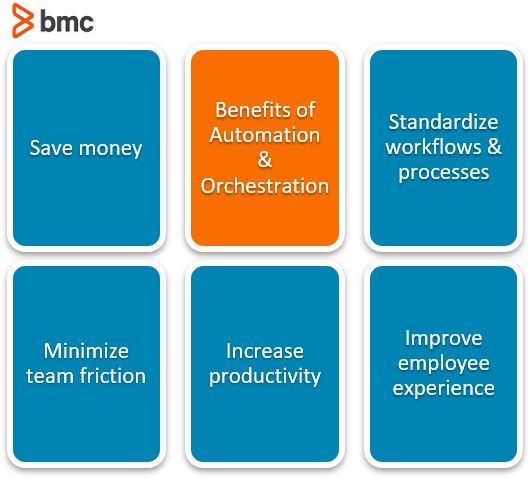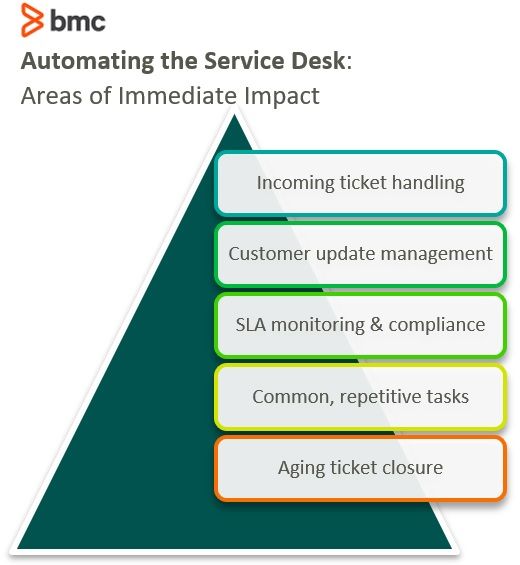I first started working on an IT service desk in 2001. Since then, the way that service desk agents perform their roles has changed dramatically, mostly for the better. Many of the repetitive, mind-numbingly boring tasks have been taken away by means of automation, and the best is yet to come.
In this article, I want to explore how automation supports successful, cost effective service desks. We’ll first explore old-school service desks, then look at areas and ways automation can benefit your IT service desk.
Old-school service desks
My introduction to the world of the service desk was providing support for a stockbroking company. We did not have a dedicated toolset for managing customer calls, relying instead on a Microsoft Excel spreadsheet and Outlook tasks.
I was responsible for taking the details of the issue being experienced by the customer, recording it in a spreadsheet and then forwarding the details, via Outlook, to a technician. Once they had contacted the customer and reviewed the issue, they would update the Outlook task and I would then transfer that to the spreadsheet. It was a rather thankless task, and not a time that I would want to repeat, but the work had to be done and I was the lucky person who got to do it.
Even for someone who was completely new to the world of the IT department and service management, it was obvious that this was not an efficient way of working. Apart from the obvious gaps in our call logging system, which were later resolved when a dedicated service desk toolset was implemented, I was able to spot common trends amongst the calls:
- Some issues were easily answered.
- Others required logs, diagnostics, and extended time to find and resolve the root cause.
- All calls had to be referred to a Level 2 support technician.
It seemed that there must be a better way to do things.
Progress in service desk operations
Fast forward almost 20 years and things have definitely improved:
- Adopting ITIL® based processes saw an uplift in incident management and change management.
- Knowledge management allowed us to capture and share resolutions for common issues.
- Our customers were able to log and follow their calls via a web-based service desk client, greatly reducing calls to the service desk phone lines.
- End users could troubleshoot their own issues using a customer facing knowledgebase.
Life on the service desk was getting easier and our customers benefited from having self-service options and easier ways to interact with support teams.
Integrated and online service catalogs showcasing standard service offerings mean that customers didn’t have to input as much information, as standard fields were already populated for them. Service levels and SLA procedures are clearly documented, setting expectations for customers around service delivery.
More recently we are seeing mobile service desk applications that are context and location aware, enabling tailored services, information and crowd-sourced collaboration. The service desk has never been more accessible and efficient!

Automation: The future of the service desk
There is always room for improvement. We need to keep looking for the next focus for the service desk to keep the momentum going. Continuing to automate is the best way forward, offering improved service to customers and freeing up service desk agents to spend time on innovation and continued service uplift.
Let’s look at some perennial challenges for the modern IT organization and see where automation can help.
Cost
Cost is an ongoing issue that will never go away. Very few organizations do not constantly look at the bottom line for their IT expenditure and consider ways to reduce it. This makes life difficult on the service desk—the greater use of technology out in the business creates more and more interactions with the service desk. Logically, this is going to raise the cost of running the service desk.
While we are able to deflect some calls by supplying self-help information through the knowledgebase, the number of people accessing IT services is growing exponentially. That means, overall, more tickets are being created as new service offerings are delivered to our customers.
Metrics on the cost of service desk calls focus on the cost of the engineer’s time. This ranges, in most studies, between $20 for a quick fix over the phone to $100 or more if a deskside visit or further investigation is required. What is often not considered is the cost to the business of the downtime incurred when issues impact productivity and valuable resources are tied up on phone calls with support engineers. This could add up to many hundreds of dollars per call.
We need to stop focusing solely on IT costs and consider true business costs when looking at how we can improve resolution times on the service desk.
The more automation we put in place, the more we enable faster fulfilment of common requests and appropriate assignment of tickets related to issues. This will reduce both the direct IT costs and overall business costs. Even the smallest reduction in handling time will have a positive effect on the bottom line.
If you have a well-defined service, and a known way to handle requests for that service, why have valuable service desk engineers involved at all? Put automation in place and take the manual costs out of the loop, thereby:
- Increasing IT efficiency
- Reducing downtime for customers
One very easy example to understand is around the automation of password resets, something that every organization has to deal with on a daily basis. One organization estimated that password resets accounted for 22% of their total service desk ticket volume. Specially, that was 46,000 calls per year that had been handled manually—at a cost of $22 per contact!
Automating resets avoided around $1 million in costs for the service desk. Add into that the decrease in productivity loss due to almost instant resolution of locked accounts, and you are looking at huge positive impacts to the organization at large. It still surprises me that there are large organizations that still handle these calls manually.
Customer satisfaction
The introduction of service catalogs has helped service desks clearly communicate what they can offer their customers, which is great for overall customer satisfaction. However, I caution:
- It’s one thing to enable your end users to easily ask for help.
- It’s another thing entirely to quickly and accurately deliver what was asked for.
Our organizations are increasingly staffed by digital natives: people who have grown up with technology that just works. They are constantly connected, and they expect rapid response times. If they log into iTunes and purchase a new song, they expect to download it instantly—not the next day, or next week.
This expectation of instant delivery means that customers are unimpressed when you respond to a request for a software installation on a PC or laptop with a timeframe of 1-2 days. We are not wandering around manually installing software using CDs. Automated configuration management tools can push software on demand.
It is imperative that we remove any manual steps in the process. There is no need to have an engineer push the button to allow the software installation. Checks and balances should be automatic with only exceptions requiring approval along the way.
Again, the cost savings here do not just impact IT budgets—productivity gains benefit the entire organization.
End-user productivity
The service desk needs to continue to ask the question:
Are we adding value to the business, or are we an obstacle to productivity?
Every service desk interaction you deflect by using automation results in a productivity gain to the end user. Best practices for enabling this productivity:
- Actual calls to the service desk should be the exception rather than the rule.
- Every standard call should have at least some level of automation attached to it.
- Physical interaction with the service desk and technical staff will then be limited to complex and unusual cases.
Automate your low-hanging fruit first
There are some service desk tasks that provide easy opportunities for automation that can have a quick and very positive effect on productivity. You may well be doing all of these, but if not—why not?

Incoming ticket processing
Removing the need for a service desk analyst to categorize and assign incoming calls is a huge timesaving opportunity, benefitting both service desk staff and customers. If you are not utilizing automatic assignment and prioritization in your service desk tool you need to start now. The less human intervention that is needed in the early stages of call processing, the better.
Customer update management
One of the most common complaints about IT departments is the lack of communication. Automating customer communication at critical stages of the call lifecycle will help to manage customer expectations and improve satisfaction.
SLA monitoring and compliance
Automating alerts for calls that are nearing escalation points, automatically reassigning calls that have exceeded SLA limits. Provide dashboard views of SLA performance to keep the service desk aware of current issues
Common and repetitive tasks
Automating simple tasks frees up service desk agents and improves productivity for the organization. These are some obvious targets for automation:
- Password resets
- Folder creation and access
- Multi-factor authentication setup
- Resource provisioning for new users
- Virtual server setup
Aging ticket closure
Leaving tickets open for extended periods of time, especially those waiting for customer feedback, is counterproductive and impacts service desk metrics. Automatically closing these calls will remove the need for calls to be manually checked and closed as they age.
If a call is closed and a customer indicates that they still require assistance, the call can be automatically reopened when a reply is received. Often a call closure is the trigger a customer needs to provide a required response.
The future is bright and exciting
Opportunities for automation will continue to increase, providing improved business productivity and freeing up IT resources to investigate innovation opportunities for the organization. Remember: Automation does not only reduce costs; automation provides a better experience for both customers and service desk staff.
The overall work experience this year has proved that remote working is not only possible—it results in high levels of productivity. We have been forced to automate many previously manual processes and provide remote support that we had not thought of in the past. Like many negative events, we now have opportunities to innovate that we had not explored previously. Automation has played a major role in success stories related to this event, we need to keep up the momentum and continue to innovate and automate wherever possible.
BMC for modern service desks
BMC helps you run your business as you reinvent it—with software, solutions, and services to help evolve to an Autonomous Digital Enterprise.
BMC Helix is the first and only end-to-end service and operations SaaS platform that’s integrated with 360-degree intelligence. This is future of service and operations management. Learn more about BMC Helix.
Additional resources
For more on automation in enterprise IT, explore the BMC Service Management Blog and these articles:







